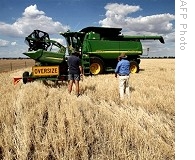VOA标准英语2008年-Drought Still Stalks Australian Farmers
搜索关注在线英语听力室公众号:tingroom,领取免费英语资料大礼包。
(单词翻译)
By Phil Mercer
Sydney
18 June 2008
The most severe drought for 100 years in Australia is getting worse. Farmers warn that this winter's wheat crop could be even smaller than last year's if rain does not come soon. Most Australian grain is exported and empty Outback grain silos have contributed to shortages and rising global prices. Australia is the third-biggest wheat exporter behind the U.S. and Canada. From Sydney, Phil Mercer reports.
 |
| Dry, stunted1 barley2 crop being prepared for harvesting on property of farmer Paul Rout3 at Grenfell in the central west of New South Wales, Australia (2007 File) |
With the drought showing no signs of easing, Australian farmers say the chances of a bumper4 wheat crop this year look slim.
Jock Lawrie is the president of the New South Wales Farmers' Association. He says that good rains at start of the sowing season did not last.
"But, of course, we had a very dry autumn right across many parts of New South Wales," Lawrie noted5. "It's knocking some of the forecasts of production down. There's no doubt they were anticipating a good winter crop but as time went by, of course, those figures get knocked back down and they still will continue to get knocked down until we get a good widespread rain right across the wheat-growing belt."
The drought - known here as the "Big Dry" - has forced more than 10,000 Australian farming families off the land over the past five years.
Australian farmers are in the middle of the growing season for their winter wheat - a crop that is planted as the weather starts to cool in April or so, and then is harvested early in the warm summer months, toward the end of the year.
Wheat farmers in New South Wales - the second-biggest wheat growing area in Australia - have seen yields shrink dramatically. And the situation elsewhere in the country is not much better.
Much of Australia's wheat harvest is sold overseas, mainly to the Middle East and Asia.
Last year's poor harvest contributed to the current international food crisis - with tight supplies and increasing demand forcing prices higher.
Ian MacDonald is the New South Wales Minister for Primary Industries.
"Up until 2002, the five-year average (harvest) was around 5.7 million tons, a large percentage of that wheat then being exported," MacDonald explained. "However, for instance, last year it was one-point-eight million tons, so there's a huge shortfall there that is obviously not going onto the international market and therefore would be putting - in conjunction with a number of other factors - pressure and upward movement in prices globally."
Australian officials have cut this year's wheat output forecast by about nine percent to just under 24 million tons. The amount of barley produced is also likely to be below previous estimates.
There is better news for the next rice crop, which is expected to hit 253,000 tons. That is up considerably6 from the paltry7 19,000 tons that was just harvested, after the drought had reduced irrigation water supplies.
Australia's canola harvest is also expected to exceed last year's figure.
Ian Macdonald says farmers still face great uncertainty8.
"Hopefully we can get some decent rain although it's not looking very good, with 62 percent of New South Wales in drought and only 13 percent satisfactory. So, the outlook at this point is rather bleak9 to say the least," he said.
Australians are not immune from inflationary effect of world grain shortages. Grocery bills here have soared 45 percent in the past decade.
Christopher Zinn from the consumer group, Choice, says Australians are generally an optimistic bunch and will be hoping that the problems will end soon.
"We're still cushioned and we're still the Lucky Country in so many ways but these realities - these global realities - are really coming home with a vengeance10 now," Zinn said. "So, I think that there is a reality check going on - might be uncomfortable. Hopefully, that mythology11 of the Lucky Country, people hope they'll steer12 their way through. But we'll see how long it lasts and how fast basically the price increases keep coming through."
News about Australia's shrinking wheat crop comes just as heavy rains and floods in the United States have destroyed millions of hectares of corn and soybean crops. The U.S. government expects the corn crop to be 10 percent lower than last year's harvest.
Australian wheat farmers who do manage to produce a healthy crop this year hope to take advantage of record prices on international markets. They are, though, unlikely to enjoy a handsome pay day. Any profit they make will be reduced by the high cost of fuel and fertilizers.
 收听单词发音
收听单词发音 




